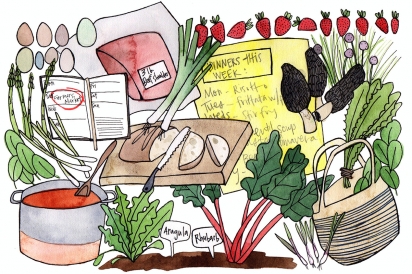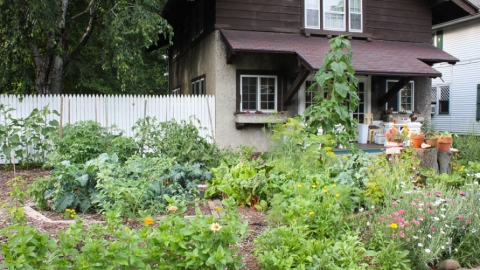How to eat local and organic on a budget
The concept of eating local and organic on a budget seems to generate a certain amount of suspicion, as if thrifty gastronomy surely requires some element of sorcery.
All too often, health is associated with wealth. Maybe it’s because our ideas of eating healthy are warped by glamourized visual presentations of food flooding social media while food bloggers poetically proclaim the health benefits of fennel pollen as they sprinkle it over microgreen salads dressed with spirulina vinaigrette. It’s no wonder that many view eating organic as a privilege reserved for the foodie elite.
But the truth is, we don’t need to empty our wallets to eat a diet built around local, organic and nutritious food. Feasting on the fruits of the land we inhabit is a gift for everyone to enjoy. To prove this, I embarked on a mission to cook for two for a week with as much local, organic food as possible on a SNAP budget of $88.
More than 45 million Americans participate in SNAP (Supplemental Nutrition Assistance Program). This program, formerly known as food stamps, helps low-income individuals and families stretch their food budget and buy healthier food.
When it came to cooking, I concentrated on creating simple meals. Also, I was deliberate about making sure none of them took more than 30 minutes to prepare. Money wasn’t the only thing I had to budget; I also had to budget my time.
The dinner rotation included a slew of hearty soups and stews anchored by beans and overwintered vegetables, wholesome stir-fries, resourceful versions of pasta primavera, frittatas studded with farmers market finds, soul-warming risottos brightened by the flavors of spring, and surreptitious lentil sloppy joes capable of banishing skepticism in any born-and-bred Midwesterner.
As I began charting my course to successful execution, it became apparent that this wasn’t just another food stamp challenge. I was on a mission to destigmatize eating on a budget.
I started by carving out an hour to plan meals for the week, being intentional about building filling and nutritious meals around what’s in season and what’s on sale. I perused weekly ads, researched where to score the best bulk prices and penciled local farmers markets into my weekly agenda.
This planning led me to shop mainly at Meijer (which accepts EBT, an electronic system that allows state welfare departments to issue benefits via a magnetically encoded payment card) and every farmers market I could get to (most of which accept EBT). Meijer’s brand of True Goodness Organics proved to be a win-win with a great selection and affordable prices—especially when considering canned goods and pantry staples.
Going in, I was concerned about having to unwaveringly adhere to my shopping list. But as I wound through the aisles, I realized eating local and organic is not an all-or-nothing venture. Sometimes it just made more sense to choose the non-organic quinoa from Peru so I could use the saved money to spring for a carton of free-range eggs from the roadside stand on the way home.
Though I was partial to the free samples Meijer doles out on weekends, shopping at farmers markets was the real treat.
Visiting a farmers market is a huge breath of fresh air. The atmosphere forces you to slow down. There’s an undercurrent of harmony that gives you an immediate sense of belonging. This environment doesn’t happen by chance—it is the result of the dedicated farmers, standing behind displays of dirt-dusted produce, who are passionate about connecting with the community.
Breakfast and lunch almost always followed the same routine: For breakfast, oatmeal topped with fruit—either fresh or frozen, depending on the sales and seasonality that week. For lunch, upcycled leftovers from the previous night’s dinner or simple sandwiches bound by homemade bread.
By the end of the challenge I had depleted my $88 budget and, much to my relief, I didn’t starve. It also became clear to me that this wasn’t the end of challenging myself to eat local on a budget. Eating like nature intended had become second nature.
Paying attention to where food comes from and committing to eating local and organic as much as possible isn’t a diet—it’s a way of living. This way of living is worth pursuing for many reasons—tastier food, a healthier environment and local economy, greater food security—but most importantly, it builds strong communities founded on the meaningful connections and relationships made between the growers and the eaters.
True richness is found in these communities that are on a mission to regard eating local and organic as a top priority, regardless of financial circumstances.
Example Meal Plan & Budget Breakdown
Monday
- Breakfast: Rhubarb porridge
- Lunch: Grilled cheese with tomato
- Dinner: Vegetable stir-fry with quinoa
Tuesday
- Breakfast: Oatmeal with fruit
- Lunch: Leftover stir-fry
- Dinner: Lentil sloppy joes with asparagus
Wednesday
- Breakfast: Oatmeal with nuts
- Lunch: Leftover sloppy joes
- Dinner: Vegetable frittata and horseradish parsnip mash
Thursday
- Breakfast: Oatmeal with maple syrup and cinnamon
- Lunch: Hummus and cucumber sandwich
- Dinner: Pasta primavera
Friday
- Breakfast: Oatmeal with nuts
- Lunch: Egg sandwich with greens
- Dinner: Tuscan bean stew
Saturday
- Breakfast: Oatmeal and fruit
- Lunch: Leftover stew
- Dinner: Spring risotto
Sunday
- Breakfast: Oatmeal and fruit
- Lunch: Leftover risotto
- Dinner: Minestrone soup and “kitchen sink” salad to use up whatever was on its last leg at the end of the week
The total cost of each meal was around $2 per person. The total cost for each day was around $6 per person.















